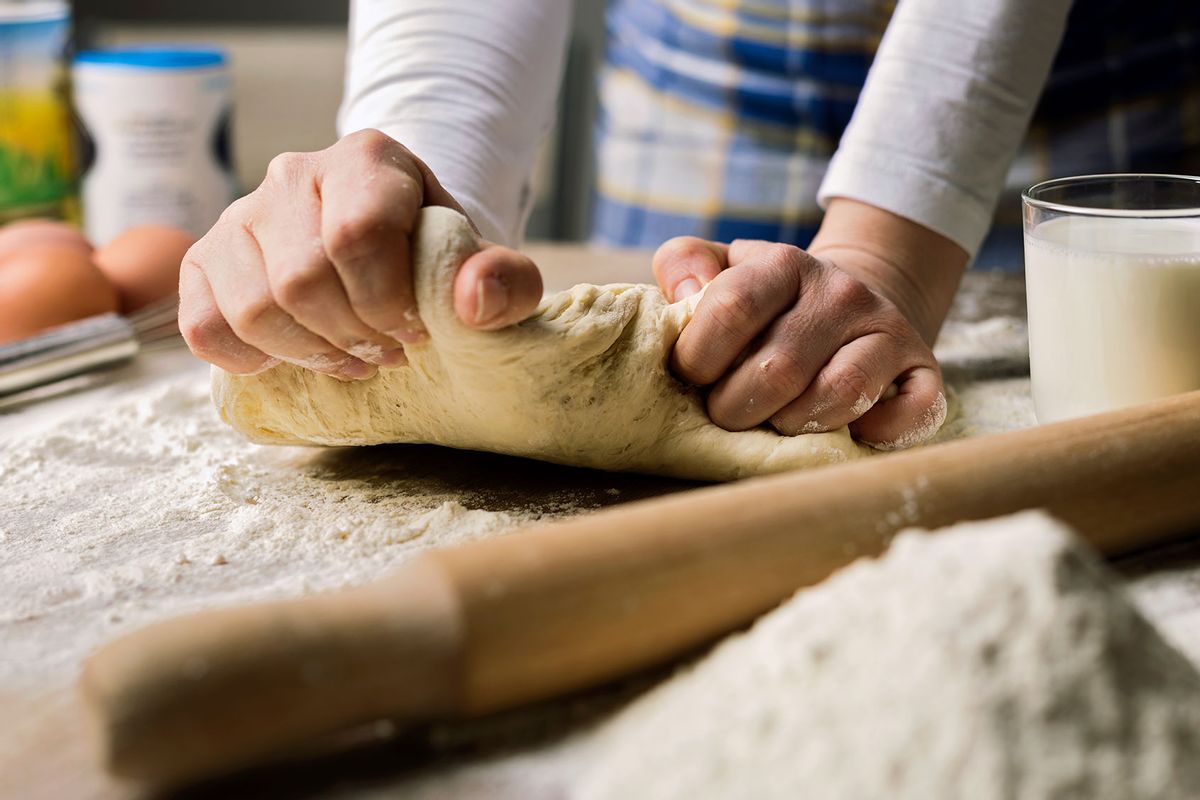The forgotten art of cooking with your hands

There’s an almost sensual pleasure found in separating egg yolks and whites by hand, something of which I was reminded recently when making a pan of late-night carbonara. While special tools exist to execute this task — from wiry mesh strainers to plastic separators meant to be hooked on the side of mixing bowls — I tend to keep it pretty low-tech in general; when I was a kid, I watched Emeril Lagasse casually crack an egg in front of a studio audience and use the neatly broken halves to pass the yolk back and forth, letting the white pool in a glass bowl below. I was blown away.
That has been my method ever since.
That said, unlike Emeril, occasionally I get in a bad crack. Such was the case the night I was making carbonara when I clumsily shattered half a shell and had to act quickly so that the yolk destined to become velvety, glossy sauce didn’t escape down the kitchen drain. I swaddled the yolk in the fold of my hand, allowing the white to slip through my fingers, before passing it to my other.. I repeated this with three more eggs, intentionally sifting the white from the yolk with my own two hands. Each time, I was freshly struck by the delicate weight of the golden orb in my palm.
It was such a small thing, but as I did so, I found myself thinking, “Why don’t I do this more often?” To be clear, I wasn’t specifically referring to separating eggs, but rather the process of actually cooking with my hands.
Let’s face it. In our fast-paced, technology-driven world, the act of preparing a meal is often more about sprinting to the finish line than enjoying the process of getting there. Such has been the case since mid-century appliance advertisements promised housewives they could “make kitchens brighter, housework lighter,” as a 1953 Coolerator spread heralded. It’s an argument that has been made for decades, from the original frozen dinner makers (“I’m late, but dinner won’t be,” said a retro Swanson ad) to Robert Wang, the inventor who made it his mission to “put Instant Pot in every kitchen.”
These days, a gadget exists to expedite nearly every step of the cooking process. Want to remove the leaves from a head of tender parsley? Try a $10.97 herb stripper. Need to drain the excess liquid from a can of tuna? Consider buying a tuna can-shaped “tuna press.” Weeknight cooking sometimes can feel like frenetic treading against the tide of culinary burnout, with unitaskers and countertop gadgets as our buoys.
But both culinary anecdotes and science point to another way: embracing the forgotten art of cooking with one’s hands.
My late-night carbonara making had inspired me to call Margaret, a friend of mine who ghostwrites recipes and cooking pamphlets for appliance brands. She had just finished a project for an electric multi-cooker company that centered on 15-minute recipes. “It’s less time than it takes to watch an episode of ‘Friends,'” she joked over the phone.
I asked her if she used kitchen gadgets more or less given her role.
“If I tell you this, you can’t use my last name,” she said with a laugh. “But my countertop appliances collect dust for that exact reason. While it’s not practical every single night, I enjoy cooking so much more when I actually feel the ingredients in my hands, even if just in some small way, like tearing lettuce for a salad versus using a knife.”
She continued: “I know it’s a little cliche, but your hands really are the best cooking tool.”
When I put out a call in a recipe-swapping group of which I’m a member, asking other home cooks what cooking tasks they preferred doing by hand, the answers were varied: making pasta, molding pastries, rolling sushi, tossing salads, kneading bread, tearing greens, forming meatballs, sprinkling salt, mashing avocado, crimping dumplings.
Weeknight cooking sometimes can feel like frenetic treading against the tide of culinary burnout, with unitaskers and countertop gadgets as our buoys.
However, when asked why, the majority of the cooks responded with a similar sentiment. Most responded with some variation of “When I really get into cooking with my hands, my brain feels different.” Scientists have actually developed a word for this: flow.
Psychologist Mihaly Csikszentmihalyi originated the term, which he uses to describe the phenomenon when someone becomes so absorbed within a creative activity that their reality outside of it is “temporarily suspended.” This is because our nervous system is only capable of processing a finite amount of information at a time.
“When we are involved in [creativity], we feel that we are living more fully than during the rest of life,” Csikszentmihalyi said during a TED talk in 2004. “You know that what you need to do is possible to do, even though difficult, and sense of time disappears. You forget yourself. You feel part of something larger.”
Csikszentmihalyi’s research makes me think of my grandmother, who, before she passed, likened snapping green beans to a form of meditation. She would run her fingers along the pointed nubs of the beans — almost like someone would press prayer beads between their fingertips — and stare at the black-eyed Susans coming up in her backyard.
Now, I’m not saying that every cooking experience needs to be spiritual or sensual. On a Wednesday night when you’re coming home after a 12-hour shift capped off with a Little League game, that’s not realistic. However, on the off-chance that you find yourself making some late-night carbonara and want to feel a little more connected to the process, start with your hands.
Read more
about this topic


